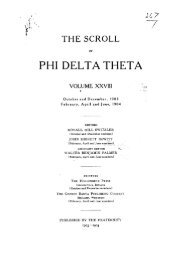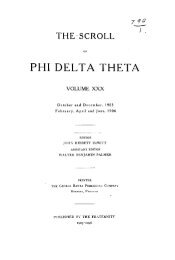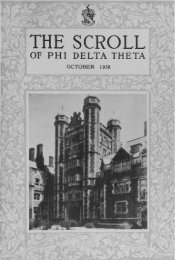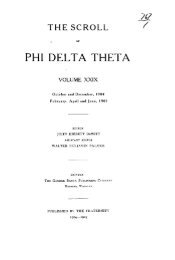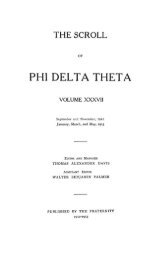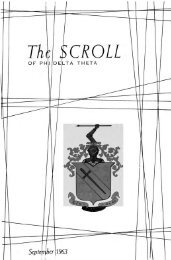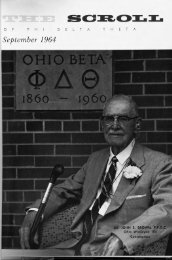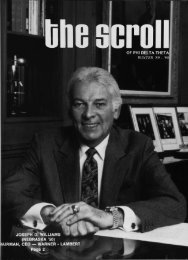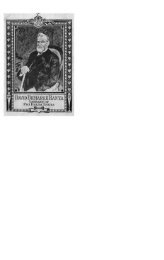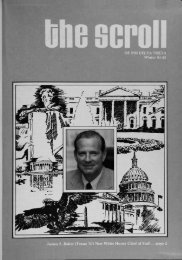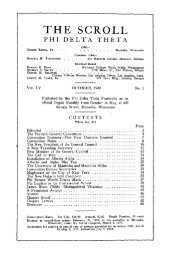1953–54 Volume 78 No 1–5 - Phi Delta Theta Scroll Archive
1953–54 Volume 78 No 1–5 - Phi Delta Theta Scroll Archive
1953–54 Volume 78 No 1–5 - Phi Delta Theta Scroll Archive
Create successful ePaper yourself
Turn your PDF publications into a flip-book with our unique Google optimized e-Paper software.
3^4 THE SCROLL of <strong>Phi</strong> <strong>Delta</strong> <strong>Theta</strong> for March, 1954<br />
PHIS IN THE SERVICE<br />
LEFT: LT. WILLIAM S. GROVER, Comell '^i (left), checks set of plans for proposed Korean civil aid station submitted<br />
by PFC R. L. Wagner (right). Grover has been in Korea since February, 195}. CENTER: DALY H. STANFORD, Auburn '52<br />
(right), receives the silver bar of his new rank, first lieutenant, from Lt. Col. Henry W. Urrutia in Fulda, Germany.<br />
RIGHT: LT. REX E. GERALD, Arizona '51, aims at a target during the recent rifle and pistol matches at Camp Fisher,<br />
Japan, where he serves as an assistant labor supervisor at the Kokwra General Depot, Brother Fisher has also served<br />
in Germany,<br />
Purdue Air Ofl&cer Freed After<br />
Three Years as Commie POW<br />
CAPT. WALDRON BERRY, Purdue '46, a career Air<br />
Force Officer, after three years in Communist prisons,<br />
returned to a tremendous welcome from the citizenry<br />
of his home town of Seymour, Ind., in September,<br />
1953.<br />
Wally's tale of war and imprisonment begins in<br />
Korea with the outbreak of the Korean War. The<br />
war brought a series of bombing runs, the one on<br />
<strong>No</strong>vember 10, 1950, being his last.<br />
Near the Yalu River that marks the boundary<br />
between <strong>No</strong>rth Korea and Manchuria, Wally's B-26<br />
was hit twice by anti-aircraft, setting fire to his left<br />
engine and sealing the bomb bay doors. With a full<br />
load of bombs—he had just started his run when<br />
• the plane was hit—and one engine gone, the crew<br />
of three had to bail out. Although fired at by<br />
<strong>No</strong>rth Korean troops on the way down, none of the<br />
trio was hit.<br />
Wally and his gunner were captured less than an<br />
hour later; the engineer was taken two or three days<br />
later.<br />
The pilot was taken to what he believed to be a<br />
<strong>No</strong>rth Korean general's headquarters and interrogated<br />
for several days on military matters. After<br />
the questioning, the men were moved about from<br />
one disorganized prison camp to another. It was<br />
shortly after his capture that Wally was locked in<br />
a shed in bitter cold weather long enough to get<br />
his hands and feet frostbitten. Although warmly<br />
dressed at the time of his capture, he was immediately<br />
deprived of his fur-lined flying jacket and<br />
boots, GI shoes—for which he was given a pair of<br />
too-small thin Korean tennis shoes—and gloves, as<br />
well as his jewelry.<br />
Wally's closest call came a few weeks after he was<br />
captured. The <strong>No</strong>rth Koreans had taken up the<br />
interrogation again. They were getting nowhere<br />
with their questions and were threatening to kill<br />
the prisoners. Then, for some reason a <strong>No</strong>rth Korean<br />
general, at the last minute ordered the guards not<br />
to shoot their POWs.<br />
Wally weighed about 155 >pounds when he was<br />
captured. <strong>No</strong>t too long afterward he was down to<br />
120. A two-week siege of diarrhea left him at a skinand-bones<br />
90. He now weighs about 132.<br />
Comrades died all around Wally. In that respect<br />
and in that he remained in relatively good health<br />
during his three years of captivity, he feels fortunate.<br />
Wally was in <strong>No</strong>rth Korean Camp <strong>No</strong>. 2 when the<br />
truce was signed. It was one of the last two camps<br />
which freed prisoners for repatriation, and Wally<br />
himself was repatriated on September 4 only two<br />
days before the giant prisoner exchange was completed.<br />
He was in the same repatriation group as<br />
Major General William F. Dean, highest-ranking<br />
Allied officer to be captured by the Reds during the<br />
war.<br />
Wally flew from Korea to Atterbury Air Force<br />
Base, with a few one-day hospital stops sandwiched<br />
itK He was met at Atterbury by his parents and was<br />
officially welcomed back to Seymour.<br />
As to his plans for the future; a'West Point<br />
graduate and a career officer in the Air Force, he intends<br />
to remain in the service.—From The Purdue<br />
•<strong>Phi</strong>.<br />
Lieutenant Wallace Heads<br />
Fort Hood Newspaper<br />
HOWARD P. WALLACE, Georgia '52, was recently promoted<br />
to the rank of first lieutenant at Fort Hood,<br />
Texas. Lieutenant Wallace is assigned to the Fort<br />
Hood Public Information Office as officer-in-charge<br />
of the Armored Sentinel, Fort Hood's weekly newspaper.<br />
Wallace received his commission in Armor<br />
through the R.O.T.C. program at the University<br />
and has been stationed at Fort Hood since the<br />
completion of the Associate Company Officers'<br />
Course at Fort Knox, Ky., in December, 1952. At<br />
Hood he has served with Reserve Command and as<br />
S-2 of the looth Tank Battalion of the ist Armored<br />
Division and the 4005th Area Service Unit.



